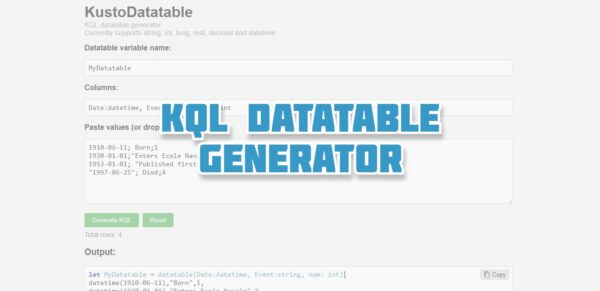Tool to generate KQL datatables
Best practices for documenting and organizing KQL
Maybe you could relate, you’re maintaining an Azure Data Explorer database or KQL database in Fabric, and there are just a bunch of tables and functions.
In this article I will explain a way how to organize and document your KQL (Kusto Query Language) queries.
Empower your IoT solution with Azure Digital Twins
With the use of Azure Digital Twins, you can create a digital representation of your physical devices or products, and you don’t have to have specialized knowledge to gain insights.
Using LightIngest on Ubuntu
It took me a while to figure out on how to install and use LightIngest on Ubuntu. So that’s why I created a small blog on how to do so.
Backup & Restore in Azure Data Explorer
One of the downfalls of Azure Data Explorer is that it lacks built-in functionality to backup & restore databases. At least not in the way we know it in SQL server. A solution that might solve the problem is using on-demand data recovery. In this article, I will investigate this solution and how it performs with large datasets.
Free in-person workshop “Experience the basics of Azure IoT, Dashboarding … and beyond” at BitBash
On January 26, 2024 Sander van de Velde and I, will organize the workshop “Experience the basics of Azure IoT, Dashboarding … and beyond” at Bitbash.
Within this free workshop, you will get an idea of the basic IoT principles by hands-on experience with a cloud connected coffeemaker, Azure IoT and Azure Data Explorer. So, bring your laptop and prepare yourself for future IoT projects.
How to deal with Change Data Capture in Azure Data Explorer – Part 2
In part 2 of the series about Change Data Capture (CDC) in Azure Data Explorer, we look at another approach on how to handle data when only changes from the device to the cloud are sent.
How to deal with Change Data Capture in Azure Data Explorer
Change Data Capture (CDC) is a design pattern to only track the changes in data. There are several ways this could be implemented. In IoT solutions, the Change Data Capture (CDC) pattern is used, to only send changes from the device to the cloud. But how to deal with this data in Azure Data Explorer for further analysis?
Authorize a Storage Account by Attribute-based access control (ABAC)
How to add authorization to an Azure Storage Account based on attributes. Attribute-based access control (ABAC) builds on role-based access control (RBAC) by adding conditions to Azure role assignments.
Geographic information in Azure Data Explorer
Located someone in Azure Data Explorer with the use of a function and a scatter plot based on an IP-address.
